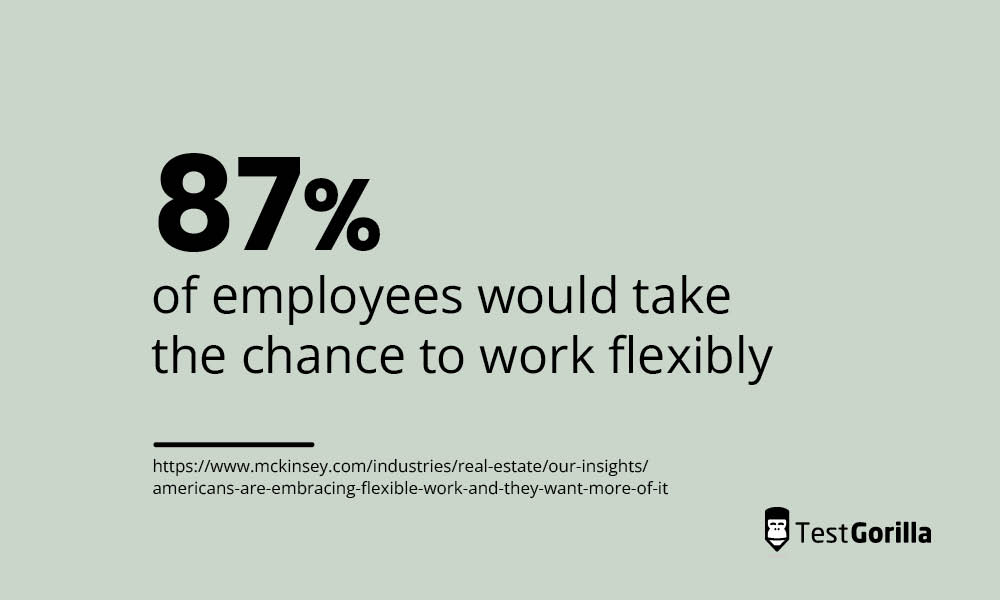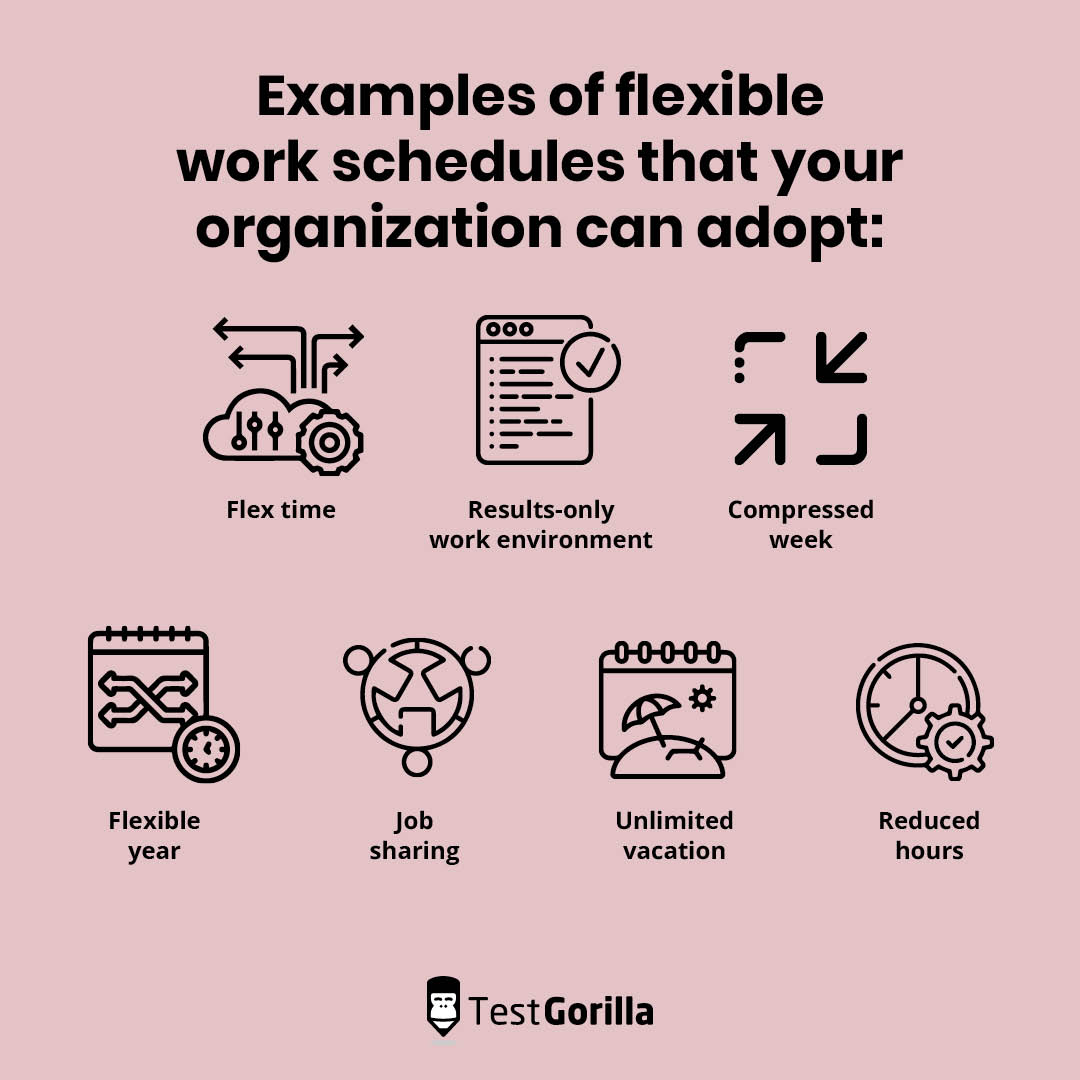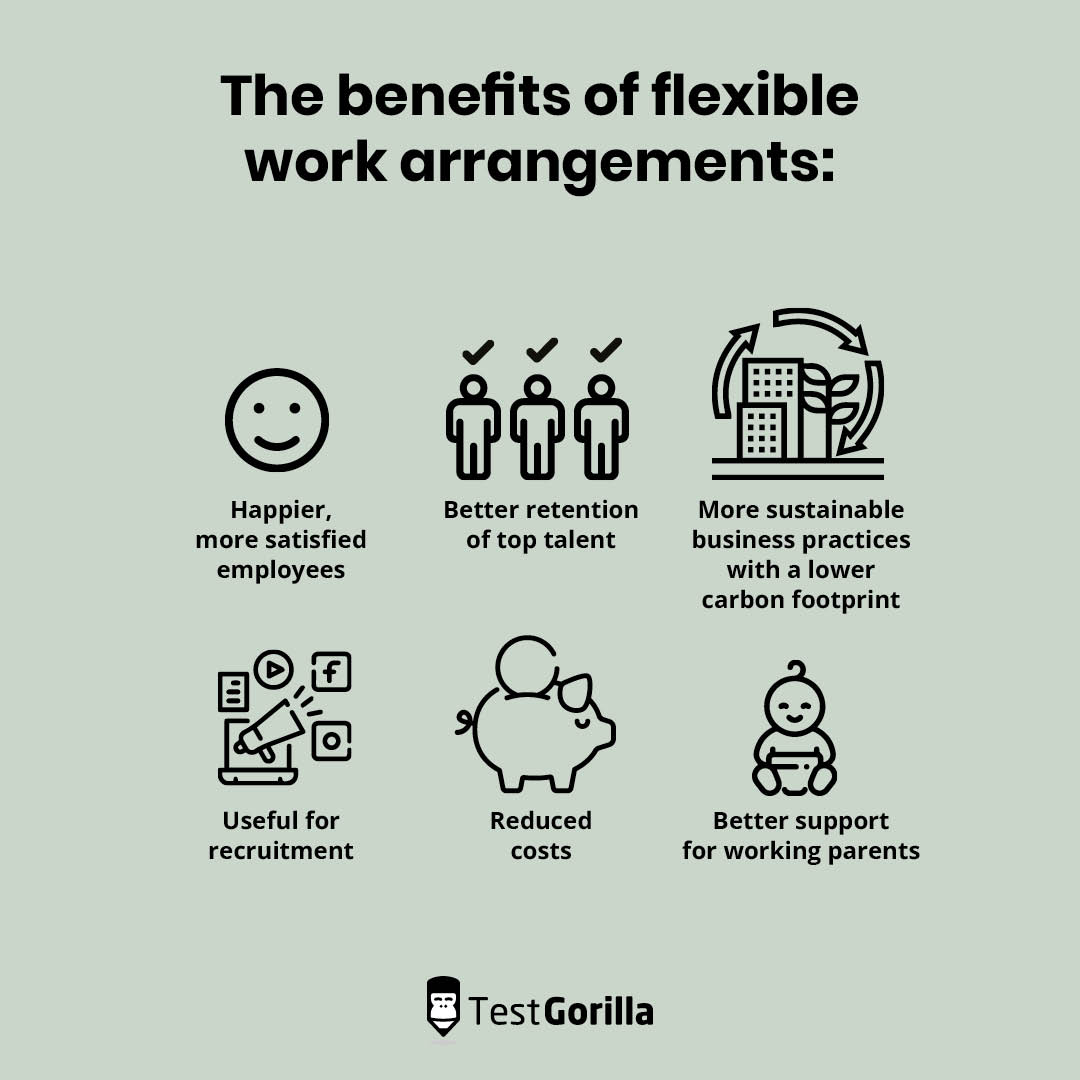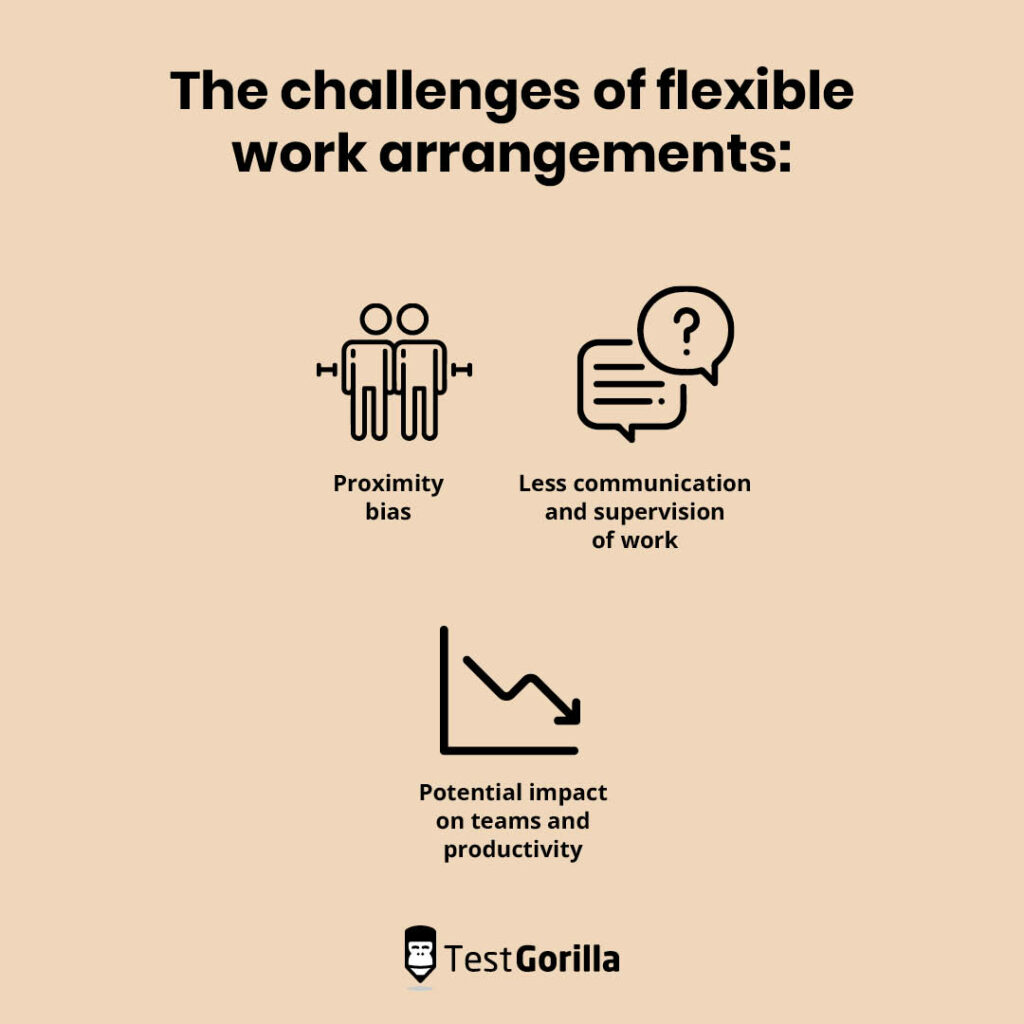7 tips for creating a better flexible working policy
The employee demand for flexible work and a better work-life balance is growing.
McKinsey’s 2022 American Opportunity Survey revealed that when employees are given a chance to work flexibly, 87% of them take it.[1]
Workers know that the future is flexible, and an increasing number of them want in on it.
Creating a flexible working policy in your company is a stellar way to attract and retain top talent and boost engagement and job satisfaction.
In this article, we will explore examples of flexible work arrangements, their benefits and drawbacks, and the best practices to build a solid flexible working policy in your organization. We will also look at ways to determine whether employees are ready for flex work.
If you’d like, you can skip straight to the best practices.
Table of contents
What is a flexible working policy?
A flexible working policy is an approach to employee scheduling that ensures an employee completes their work but allows them flexible working hours with varying start and end times.
A flexible working hours policy breaks down the traditional structure of a job role having certain rigid hours per day. Different types of policies accomplish this in various ways.
Here are a few examples of flexible work schedules that your organization can adopt:
Flex time
Results-only work environment
Compressed week
Flexible year
Job sharing
Unlimited vacation
Reduced hours
Let’s look into the details.
Flex time
Flex time is one of the most common types of flexible work. It means the employee works a set number of hours and can give input on their start and end times.
Flex time may or may not specify core hours when a person must be working. For example, the start and end hours could vary, but workers must be present from 2:00 PM to 4:00 PM. This structure helps with co-ordinating team efforts and meetings.
Results-only work environment
In a results-only work environment, employees’ hours of work don’t matter. They can work whatever hours they want as long as they produce the desired results.
This flexible work option relies heavily on trust since each employee is completely accountable and autonomous.
These work environments are typically best for companies that rely greatly on freelancers and contractors, although more traditional workplaces can adopt this practice, too.
JL Buchanan, a retail consulting firm, adopted a results-only work environment back in 2009 and has since seen increased employee engagement, productivity, and efficiency. It has also enjoyed boosted profits and top-line sales.
Compressed week
A compressed workweek enables employees to work a full workweek (typically 35-40 hours) in fewer days.
This might look like four 10-hour days instead of five 8-hour days. Another variation is the 9/80 work schedule, which divides an employee’s work into two-week slots. This gives them an extra hour of work from Monday to Thursday to ensure they get a Friday off every two weeks.
A compressed week is easiest to adopt for organizations that could feasibly close for a day. However, you can also split your workers into two teams to ensure there’s always someone available for essential operations.
Here are a few other ways to adopt a flexible working policy:
Flexible year: You calculate hours on a yearly basis
Job sharing: Employees divide their schedules among themselves to do the same job
Unlimited vacation: You offer unlimited vacation time, though workers need to meet certain stipulations and requirements
Reduced hours: Employees’ work time is less than the standard for their role, and their salary is adjusted as needed
You can combine many of these types of schedules with flexible working arrangements, such as remote and hybrid working. For more information, read our article on remote work best practices.
The benefits and challenges of flexible work arrangements
Let’s discuss the top pros and cons of adopting a flexible working policy.
There are considerations you need to address for even the best flexible working policies if you want them to run smoothly. However, we believe the benefits far outweigh any drawbacks.
Here’s a summary of the main advantages and challenges of flexible work arrangements:
Benefits | Challenges |
Happier, more satisfied employees; Better retention of top talent; More sustainable business practices with a lower carbon footprint; Useful for recruitment; Reduced costs; Better support for working parents | Proximity bias; Less communication and supervision of work; Potential impact on teams and productivity |
Let’s talk about them in full.
The benefits
First, let’s cover the benefits your company will see by adopting a flexible working policy.
1. Happier, more satisfied employees
According to a recent report by Owl Labs, 84% of employees believed they would be happier working remotely after the pandemic, with some even willing to take a pay cut to do so. More than half of those who worked from home during the pandemic would also look for a new job with more flexibility if they no longer had the option to work remotely.
Giving employees flexibility and autonomy over their work improves engagement, increases job satisfaction, and reduces stress burnout. All of this contributes to a higher quality of work.
2. Better retention of top talent
Flexible scheduling significantly reduces employee turnover, particularly for workers with children, alternative lifestyles, and other jobs.
One survey showed that 55% of workers say they would leave their jobs if they lacked control over the scheduling.
Your company is more likely to retain employees if you give them more control and autonomy over their work hours.
Offering your employees flexibility will enable them to stay with the job they chose and meet the other demands in their lives.
3. More sustainable business practices with a lower carbon footprint
A flexible work hours policy is better for the environment if combined with remote working and hybrid offices.
When telecommuting is an option and employees aren’t regularly at the office from nine to five, a company can reduce its energy output and use fewer resources.
This means that a flexible working policy can help you cut down on things like the following:
Electricity
Water
Waste like paper, styrofoam cups, and other disposable products
The environment will also benefit from telework, thanks to less commuting. Reducing the use of cars, subways, and buses contributes to better air quality.
4. Useful for recruitment
Offering flexible hours is an attractive prospect for candidates. It improves your brand image and brings in desirable talent.
More organizations are offering a flexible working policy as a benefit for job seekers because an increasing number of candidates are demanding it.
Your company wouldn’t be the first to use flexible work hours as a recruitment tool. Take TrueNorth Group, for example:
This recruitment post lists flexible hours and remote and hybrid work as top perks, alongside healthcare, vacation time, and a pet-friendly office.
Candidates want work autonomy, and you’ll attract the best when you offer what they’re after.
5. Reduced costs
Flexible hours can reduce your company’s costs in a couple of ways.
First of all, a flexible working policy enables your organization to reduce turnover (as we mentioned above), which means you can save on hiring, onboarding, and training costs. On average, the current cost-per-hire is $4,000.
Another way it can reduce costs is on overhead. With a flexible working policy in place, you can have a smaller office space and spend less on utilities and “little things” (coffee and various supplies).
These “little things” aren’t actually so little, with coffee alone costing businesses an average of $50 to $125 per employee a year.
6. Better support for working parents
A flexible schedule is an absolute lifesaver for working parents.
Juggling the demands of your work is already a challenge, but it’s even more difficult to handle them and care for a child. Parents have to balance a schedule that takes into account their job, childcare, school, and potentially another working parent.
A top factor in retaining this essential talent is facilitating the management of these hectic schedules.
Read our article on supporting working parents for more on this topic.
The challenges
Now, let’s cover the challenges that can come with a flexible work hours policy.
1. Proximity bias
Proximity bias is a bias employers may have against employees who work flexibly simply because they aren’t around them.
This bias is a significant concern for employers adopting flexible work arrangements and is crucial to consider as we start to emerge from the pandemic.
Proximity bias is like any other kind of unconscious bias – we’re unaware of how it affects our own behavior and decisions. Companies need to be active in their approach to flexible work schedule policies to mitigate the risk of bias.
2. Less communication and supervision of work
Flexible hours and remote work can come with less supervision, direction, and communication, particularly in results-only work environments.
You can combat this challenge if you tackle it proactively and deliberately.
The best way to do this is to introduce communication policies and guidelines from the beginning and ensure they are clear and accessible to everyone.
3. Potential impact on teams and productivity
One challenge of flexible work that organizations are wary of is the potential loss of office culture and its impact on teamwork and productivity.
If this is a major concern for your company, you could implement core hours in your flexible working policy. If you require everyone to log on or be in-office between X and Y hours, you can better synchronize team activities and meetings.
7 flexible working policy best practices
We’ve discussed the pros and cons of implementing a flexible working policy, so let’s move on to the main question:
How do you implement flexible working hours?
Let’s get right into it with a summary of our top best practices:
Best practice | Description |
1. Make sure flexible working hours are appropriate to the role | Assess each role and determine if it can be made flexible |
2. Use skills testing to confirm employees are ready for flexible work | Test your employees’ skills to find out if they’re a fit for a flexible schedule |
3. Offer remote working opportunities for flexible staff | Take your flex work a step further by offering flexible employees the chance to work remotely |
4. Carefully consider if employees need to work core hours or if they can be fully flexible | Analyze the nature of the work to determine if core hours are needed |
5. Build an official, clearly defined procedure for flexible hours | Write up a formal process for flex work to ensure you treat each employee fairly |
6. Have the courage of your convictions | Stand by your decisions even if others question you |
7. Upgrade your tech stack to empower flexible working | Adopt and implement software to ensure the flexible work experience is successful |
Let’s flesh out these practices.
1. Make sure flexible working hours are appropriate to the role
The vast majority of employees desire flexible work, but not every role transfers to this type of arrangement.
As you implement a flexible working policy, take the time to assess each role.
Specifically, you should consider the following:
Is the role customer-centric?
Could employees feasibly perform the role just as well with flex hours?
Customer-centric roles like retail, healthcare, and customer service would have a tough time going completely flexible. However, customer service workers may be able to work flex time with core hours.
Examples of roles that can’t possibly have flexible hours include vehicle technicians and warehouse workers.
However, writers, programmers, marketing professionals, and web developers can often smoothly transition to flex hours with little hassle.
2. Use skills testing to confirm employees are ready for flexible work
It’s one thing if an employee wants flexible hours – but are they ready for such a different work structure?
It’s important to ensure your workers are ready for a complete change because you don’t want a high performer’s quality of work to suffer because they are unprepared.
You can prepare employees for the switch by assessing their skills with online skills testing.
Testing core and soft skills will help ensure an employee is ready for such a huge change in scenery. In your assessment, try including tests such as TestGorilla’s:
You’ll be much more confident sending a worker into a new environment when you feel assured that they possess the skills needed to succeed.
3. Offer remote working opportunities for flexible staff
Once you’ve implemented a few roles into a flexible working policy, try making a handful of them remote or hybrid.
Remote and hybrid work increase employee productivity and efficiency, but it’s much easier to transfer flex roles to this model than to build them as remote from the start.
Your company can see the benefits associated with remote work by taking small steps toward it rather than taking a big leap into a full-time remote arrangement.
Remote work can reduce stress and increase engagement, but you should still take steps to avoid working-from-home depression in employees.
4. Carefully consider if employees need to work core hours or if they can be fully flexible
Do you need to set a specific time and number of hours that flex employees must be present? Or can certain roles be fully flexible and allow each employee to decide their start and end times?
Core hours can be useful for work environments that rely heavily on team dynamics, co-ordination, and frequent meetings. It can be useful to have a handful of hours that all employees must be present for every work day.
However, for some workplaces, you can easily schedule meetings for different times from week to week. Teamwork isn’t as foundational for these workplaces, and many employees work independently.
As you consider this, remember not to let assumptions and biases get in the way. If you need core hours, set them – but if you don’t, pass them by.
5. Build an official, clearly defined procedure for flexible hours
Informal policies and practices lead to inconsistency and possibly discrimination.
Adopting an inconsistent, undefined flexible working policy could lead to resentment, low retention, or even legal issues.
You can avoid this by creating a clear, detailed, formal written policy. Take the time to review the process with your human resources department, a lawyer, and anyone else you believe contributes to your employees’ experiences.
It’s critical to build an inclusive, defined process for eligible employees to apply for flexible working hours to keep everything as transparent and fair as possible.
6. Have the courage of your convictions
You may face adversity while adopting a flexible working policy for your business.
Unfortunately, there are many unfair biases about flex work floating around, with some people calling it “lazy” and trying to usher traditional work hours back in as fast as possible.
However, the message from the top doesn’t always reflect the legal standpoint.
You may have to deal with some opposition from colleagues, other companies, and partnerships. But if it’s what you believe will help your business, you should stand by your beliefs.
As an employer, you must do what’s best for your company and believe in it. If you think flexible working hours would benefit your organization, stand by your decision even if popular opinion may judge you.
7. Upgrade your tech stack to empower flexible working
In this day and age, the right tech and tools make nearly every business process easier.
Managing employee time should be one of your top considerations when implementing a flexible working hours policy, so it should also be your main focus when building your tech stack.
Try integrating a Time Management test into your online skills assessment. Knowing your employees have great time-management skills makes it easier to trust them to manage their time.
You can also invest in a time-tracking system, such as Toggl Track or Harvest, to help your flexible employees keep track of their days without being invasive.
Additionally, this tech can help you track time if your business relies on time tracking for invoicing.
Reimagine the workplace with a flexible working hours policy
Implementing a flexible working policy improves your employees’ productivity and engagement and drastically reduces turnover among employees who desperately need flex work, such as parents and students.
We learned about different types of flexible working schedules and the pros and cons of adopting a flexible work hours policy. And don’t forget the seven flexible working policy best practices:
Assess job roles for eligibility
Use skills testing to confirm employees are ready
Offer remote positions to flex workers
Determine the need for core hours
Create a formal application process
Stand behind your actions and believe in them
Upgrade your tech and tools
With a little time and effort, you’ll be well on your way to reaping the benefits of flex workers.
After your flexible working policy is in place, try using an internal talent marketplace to advertise and fill the role internally.
You can also check out our 16 personalities test to help determine whether an employee is suited to flex work. Get started for free today and start making better hiring decisions, faster and bias-free.
Source
“Americans are embracing flexible work—and they want more of it”. (June 23, 2022). McKinsey & Company. Retrieved October 13, 2022. https://www.mckinsey.com/industries/real-estate/our-insights/americans-are-embracing-flexible-work-and-they-want-more-of-it
Related posts
You've scrolled this far
Why not try TestGorilla for free, and see what happens when you put skills first.
Latest posts
The best advice on pre-employment testing, in your inbox.
No spam. Unsubscribe at any time.

Hire the best. No bias. No stress.
Our screening tests identify the best candidates and make your hiring decisions faster, easier, and bias-free.
Free resources
This checklist covers key features you should look for when choosing a skills testing platform
This resource will help you develop an onboarding checklist for new hires.
How to assess your candidates' attention to detail.
Learn how to get human resources certified through HRCI or SHRM.
Learn how you can improve the level of talent at your company.
Learn how CapitalT reduced hiring bias with online skills assessments.
Learn how to make the resume process more efficient and more effective.
Improve your hiring strategy with these 7 critical recruitment metrics.
Learn how Sukhi decreased time spent reviewing resumes by 83%!
Hire more efficiently with these hacks that 99% of recruiters aren't using.
Make a business case for diversity and inclusion initiatives with this data.
























